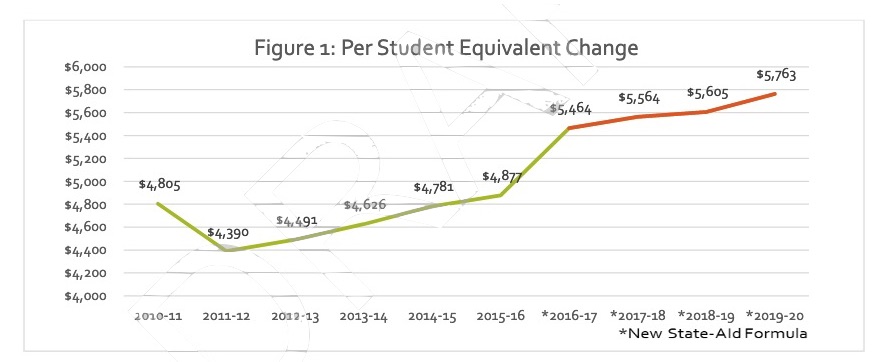With Donald Trump and Kristi Noem waging a destructive constant war with unpleasant reality, it’s refreshing just to read issue memos from the Legislative Research Council. I mean, seriously, could we just get rid of the Governor and the Legislature, have the LRC publish policy analyses every day, and put every law to a public vote?
The LRC has produced an issue memorandum on our K-12 education funding formula. The draft opens with this instructive graph of how much we calculate should be spent per student by the combination of state aid and local effort:

The period charted, from Fiscal Year 2011 to Fiscal Year 2020, shows the two great shifts of the past decade: Governor Dennis Daugaard’s hard austerity cuts in FY2012 to make up for the reckless deficit spending of his predecessor, Mike Rounds, and the one-time boost Governor Daugaard gave to K-12 funding in FY2017 to restore those cuts, raise teacher pay, and temper a teacher exodus. Aside from those two years of seemingly radical budgeting in Pierre, the graph shows slow and steady increases in how much we spend per student in our K-12 public schools.
Funny thing is, even including those two radical swings, the average annual rate of growth from $4,805 per student in FY 2011 to $5,763 per student in FY2020 is a mere 2.04%. The great teacher pay raise of 2016 only undid the damage of the Daugaard cuts from five years prior and put teacher pay back on the track it had been before.
That 2.04% is still a little better than what teachers would have gotten if we had strictly followed the funding formula. The index factor (SDCL 13-13-10.1(3)) says K-12 funding is supposed to increase by 3% or the consumer price index, whichever is less. The CPI has run cold all decade, not surpassing 3% since 2011. Assiduously applying those lower CPIs as the index factor to K-12 funding would have led to per-student spending last year of $5,580, about 3% less than where we ended up last year. Multiply that by the 136,000 students in our K-12 system, and the Legislature’s willingness over the long term to exceed the index factor put just about $25 million more into K-12 education last year than strict adherence to the formula would have budgeted. That surplus, divided evenly among about 9,700 teachers, means our average teacher salary is about $2,570 higher than it could have been under strict adherence to the formula.
Since nobody has commented on this blogging, Mr. H, grudznick assumes it is because it is over the heads of various out of state name callers or because the legislatures have decided they should get raises that outstrip their own budgets. This is from the same incompetent Council of Researchers who put the budget in the place and who is now outstripping a budget according to KELOLAND journalists. You cannot make this up.